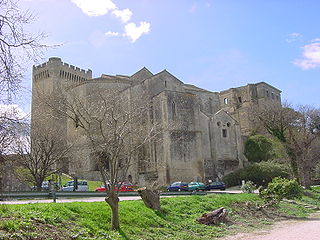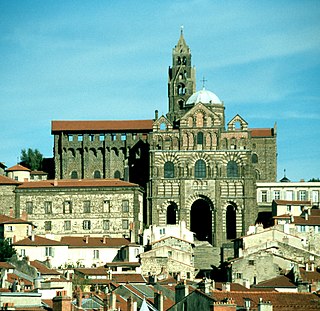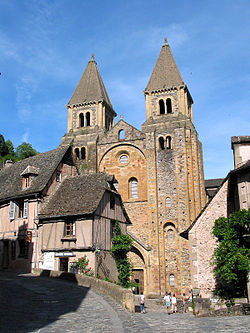
Romanesque architecture is an architectural style of medieval Europe that was predominant in the 11th and 12th centuries. The style eventually developed into the Gothic style with the shape of the arches providing a simple distinction: the Romanesque is characterized by semicircular arches, while the Gothic is marked by the pointed arches. The Romanesque emerged nearly simultaneously in multiple countries ; its examples can be found across the continent, making it the first pan-European architectural style since Imperial Roman architecture. Similarly to Gothic, the name of the style was transferred onto the contemporary Romanesque art.

Vézelay Abbey is a Benedictine and Cluniac monastery in Vézelay in the east-central French department of Yonne. It was constructed between 1120 and 1150. The Benedictine abbey church, now the Basilica of Sainte-Marie-Madeleine, with its complex program of imagery in sculpted capitals and portals, is one of the great masterpieces of Burgundian Romanesque art and architecture. Sacked by the Huguenots in 1569, the building suffered neglect in the 17th and the 18th centuries and some further damage during the period of the French Revolution.

Conques is a former commune in the Aveyron department in Southern France, in the Occitania region. On 1 January 2016, it was merged into the new commune of Conques-en-Rouergue.

Montmajour Abbey, formally the Abbey of St. Peter in Montmajour, was a fortified Benedictine monastery built between the 10th and 18th centuries on what was originally an island five kilometers north of Arles, in what is now the Bouches-du-Rhône Department, in the region of Provence in the south of France.

Saint Faith or Saint Faith of Conques is a saint who is said to have been a girl or young woman of Agen in Aquitaine. Her legend recounts how she was arrested during persecution of Christians by the Roman Empire and refused to make pagan sacrifices. Saint Faith was tortured to death with a red-hot brazier. Her death is sometimes said to have occurred in the year 287 or 290, sometimes in the large-scale Diocletianic Persecution beginning in 303. She is listed as "Sancta Fides, Virgin and martyr", in the martyrologies.
In French Gothic architecture, the Rayonnant style is the third of the four phases of Gothic architecture in France, as defined by French scholars. Related to the English division of Continental Gothic into three phases, it is the second and larger part of High Gothic.

The Basilica of Saint-Sernin is a church in Toulouse, France, the former abbey church of the Abbey of Saint-Sernin or St Saturnin. Apart from the church, none of the abbey buildings remain. The current church is located on the site of a previous basilica of the 4th century which contained the body of Saint Saturnin or Sernin, the first bishop of Toulouse in c. 250. Constructed in the Romanesque style between about 1080 and 1120, with construction continuing thereafter, Saint-Sernin is the largest remaining Romanesque building in Europe. The church is particularly noted for the quality and quantity of its Romanesque sculpture. In 1998 the basilica was added to the UNESCO World Heritage Sites under the description: World Heritage Sites of the Routes of Santiago de Compostela in France.

Saint-Étienne-du-Mont is a church in Paris, France, on the Montagne Sainte-Geneviève in the 5th arrondissement, near the Panthéon. It contains the shrine of St. Geneviève, the patron saint of Paris. The church also contains the tombs of Blaise Pascal and Jean Racine. Jean-Paul Marat is buried in the church's cemetery.

The Cathedral of Saint Lazarus of Autun, commonly known as Autun Cathedral, is a Roman Catholic cathedral in Autun and a national monument of France. Famous for its Cluniac inspiration and its Romanesque sculptures by Gislebertus, it is a highlight of Romanesque art in Burgundy. It is the seat of the Bishop of Autun. The Bishop of Autun set forth the construction of St. Lazarus Cathedral as a result of the large movement of pilgrims travelling to Vezelay as they progressed on the pilgrimage route to Santiago de Compostela.

Troyes Cathedral is a Catholic church, dedicated to Saint Peter and Saint Paul, located in the town of Troyes in Champagne, France. It is the episcopal seat of the Bishop of Troyes. The cathedral, in the Gothic architectural style, has been a listed monument historique since 1862.

The Basilica of Saint Servatius is a Roman Catholic church dedicated to Saint Servatius, in the city of Maastricht, the Netherlands. The architecturally hybrid but mainly Romanesque church is situated next to the Gothic church of Saint John, backing onto the town's main square, Vrijthof.

Le Puy Cathedral is a Roman Catholic church located in Le Puy-en-Velay, Auvergne, France. The cathedral is a national monument. It has been a centre of pilgrimage in its own right since before the time of Charlemagne, as well as being a stopover on the pilgrimage route to Santiago de Compostela. Since 1998 it has been part of a multi-location UNESCO World Heritage Site along France's Santiago pilgrimage routes. It is the seat of the Bishop of Le Puy.

Beaulieu-sur-Dordogne is a commune in the Corrèze department in the Nouvelle-Aquitaine region, central France. Beaulieu is a medieval city, originally dominated by its great abbey of St Pierre, of which only the abbey church remains. On 1 January 2019, the former commune Brivezac was merged into Beaulieu-sur-Dordogne.

Early Gothic is a term for the first phase of Gothic style, followed by High Gothic and Late Gothic, dividing the whole Gothic era into three periods. It is defined as a style that used some principle elements of Gothic, but not all. Especially, it had no fine tracery. It marks the first phase of a division of Gothic style into three periods. If it is used for all countries, it has to be regarded that there may be special terms for the styles of single countries, such as Early English in England.

The Church of St Candida and Holy Cross is an Anglican church in Whitchurch Canonicorum, Dorset, England. A Saxon church stood on the site but nothing remains of that structure. The earliest parts of the church date from the 12th century when it was rebuilt by Benedictine monks. Further major rebuilding work took place in the 13th century and in the 14th century the church's prominent tower was constructed. The church features some Norman architectural features but is predominantly Early English and Perpendicular. George Somers, founder of the colony of Bermuda, is buried under the vestry and the assassinated Bulgarian dissident Georgi Markov is interred in the churchyard. It is an active Church of England parish church in the deanery of Lyme Bay, the archdeaconry of Sherborne, and the diocese of Salisbury. It is one of only two parish churches in the country to have a shrine that contains the relics of their patron saint. The relics belong to St. Candida to whom the church is dedicated. The church been designated by English Heritage as a Grade I listed building.

The Romanesque style of architecture was introduced in Portugal between the end of the 11th and the beginning of the 12th century. In general, Portuguese cathedrals have a heavy, fortress-like appearance, with crenellations and few decorative elements apart from portals and windows. Portuguese Romanesque cathedrals were later extensively modified, among others the Old Cathedral of Coimbra, although it only had some minor changes.

Romanesque architecture appeared in France at the end of the 10th century, with the development of feudal society and the rise and spread of monastic orders, particularly the Benedictines, which built many important abbeys and monasteries in the style. It continued to dominate religious architecture until the appearance of French Gothic architecture in the Île-de-France between about 1140 and 1150.

The 'A' of Charlemagne is a relic purportedly gifted to the Abbey Church of Sainte-Foy by the emperor Charlemagne himself. It is a gold and silver open triangle with ornate jewels on the arms. The base is stronger and serves more of a structural purpose rather than an aesthetic purpose. The piece served a greater purpose over time as the attraction to the church became more focused on visiting the relic that Charlemagne presented to the church rather than its original function of honoring Saint Faith. The church itself was a common destination of medieval pilgrimage, and the change in purpose for these pilgrimages became highly focused on visiting this relic and attracted a different audience than before.

Gothic cathedrals and churches are religious buildings created in Europe between the mid-12th century and the beginning of the 16th century. The cathedrals are notable particularly for their great height and their extensive use of stained glass to fill the interiors with light. They were the tallest and largest buildings of their time and the most prominent examples of Gothic architecture. The appearance of the Gothic cathedral was not only a revolution in architecture; it also introduced new forms in decoration, sculpture, and art.






































